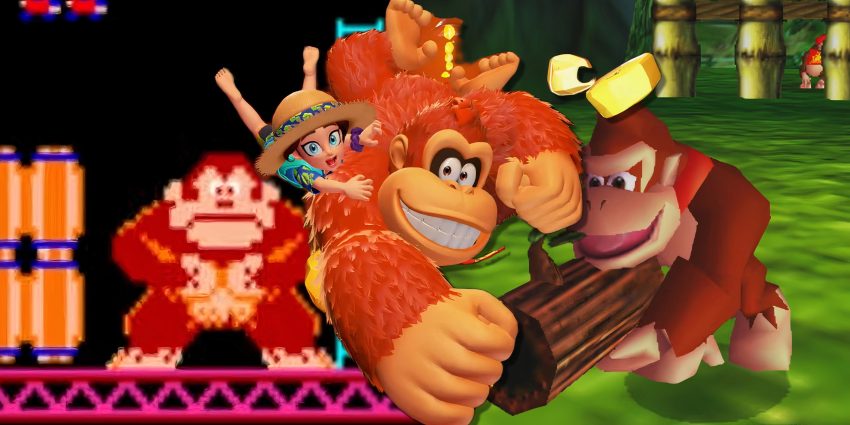The Legacy of Donkey Kong: A Journey Through Time
Donkey Kong has been a cornerstone of Nintendo’s identity, shaping the gaming landscape with its iconic arcade gameplay and endless challenges. From its debut in the original Donkey Kong to modern titles like Donkey Kong Bananza, the franchise has continually evolved while maintaining its core appeal.
Donkey Kong: The Original Arcade Game That Defined a Generation
The original Donkey Kong was more than just a game; it was a pivotal moment in video game history. Featuring Mario as the hero trying to rescue Pauline from the titular ape, the game introduced players to side-scrolling action and set the stage for future platformers. Without this title, Nintendo might not have become the industry giant it is today. The game’s difficulty was designed to keep players engaged, ensuring they kept inserting quarters until they could progress further.
Despite its simplicity, Donkey Kong remains a challenge for many. Its endless loop of increasing difficulty ensures that even seasoned players can find themselves struggling with the same obstacles repeatedly. While not the hardest arcade game ever made, it undeniably left an indelible mark on the gaming world.
Donkey Kong Country: A New Era for the Franchise
When the Super Nintendo Entertainment System (SNES) launched, Nintendo brought back Donkey Kong in a new and exciting way. Donkey Kong Country, developed by Rare, introduced 2.5D visuals and sidescrolling gameplay that captivated fans. This game became a landmark title, spawning its own franchise and setting a high bar for future entries.
Collecting all items, including letters that spell “Kong” and every banana, requires patience and skill. Some levels are long and demanding, with intricate platforming sections that test players’ abilities. Completing the game at 100% often leads to alternate endings, adding an extra layer of challenge and reward.
Donkey Kong Country 3: A Slightly Overlooked Entry
Donkey Kong Country 3: Trixie’s Double Trouble! is often considered the black sheep of the original Rare era. While it retains the addictive 2D action side-scrolling gameplay that fans loved, it didn’t distinguish itself enough from its predecessors. However, it still offers a quality experience, with Trixie and Kiddy Kong taking center stage in their quest to stop Baron K. Roolenstein.
The game is shorter than previous entries, making it more manageable for fans who want to complete it without too much hassle. Despite its lack of innovation, it remains a memorable part of the series.
Donkey Kong Country Returns: A Return to Basics
When Donkey Kong Country returned on the Wii, it marked a triumphant return to 2D gameplay with 3D visuals. The game was praised for its visuals, sound, and gameplay, offering a mix of collecting bananas and battling the Tiki Tak Tribe.
However, the original version on the Wii featured motion controls that were both mandatory and sometimes frustrating. The HD remaster for the Nintendo Switch allowed players to use traditional controls, making the experience slightly easier and more accessible.
Donkey Kong Country: Tropical Freeze: A Balanced Adventure
Originally released exclusively for the Nintendo Wii U, Donkey Kong Country: Tropical Freeze received a remaster on the Nintendo Switch. This game features four playable characters—Donkey Kong, Diddy Kong, Dixie Kong, and Cranky Kong—with Funky Kong as a bonus character.
While some levels can be challenging, especially towards the end, the game strikes a fine balance between difficulty and enjoyment. It offers a consistently engaging experience that never becomes overly stressful or tedious.
Donkey Kong Bananza: A New Open-World Experience
Donkey Kong Bananza represents a bold leap forward for the franchise. With 4K visuals on the Nintendo Switch 2, the game introduces open-world gameplay similar to Super Mario Odyssey. Players control Donkey Kong and Pauline as they explore the planet to collect gold and bananas.
The game maintains a balanced difficulty throughout, ensuring that players remain engaged without feeling overwhelmed. As the story progresses, Donkey Kong faces various challenges, from battling bosses to completing objectives, all while keeping the fun and engaging tone intact.
Donkey Kong Country 2: Diddy’s Kong Quest: A Definitive Title
Donkey Kong Country 2: Diddy’s Kong Quest is often regarded as the definitive title in the series. It follows a similar concept to its predecessor but expands on it with a longer gameplay experience. Players move left and right to collect bananas, letters, and other items, gradually increasing in difficulty over time.
The game allows players to take on the role of Diddy Kong in his own side-scrolling adventure, offering a fresh perspective on the franchise. With more collectibles and intricate levels, it pushes players to their limits in some instances.
Diddy Kong Racing: A Unique Racing Experience
Diddy Kong Racing is not your typical Mario Kart clone. It is a demanding racing game known for punishing players for even the slightest mistakes. The game emphasizes unique perks and weaknesses for each character, which can significantly impact race outcomes, especially in multiplayer mode.
Interestingly, Donkey Kong himself was excluded from the roster in favor of other Kongs and characters from other Rare games, such as Conker’s Bad Fur Day and Banjo-Kazooie. This decision added an unexpected twist to the game.
Donkey Kong 64: A Divisive N64 Title
Donkey Kong 64, inspired by Rare’s 3D platformer Banjo-Kazooie, remains a divisive title on the Nintendo 64. Part of its difficulty stems from its gimmick of having multiple characters to play as, each with specific collectibles that can only be obtained by them. This often leads to excessive backtracking, which can frustrate players rather than thrill them.
Despite its flaws, Donkey Kong 64 remains a significant part of the franchise’s history, showcasing the evolution of platforming games and the challenges of balancing gameplay mechanics.
